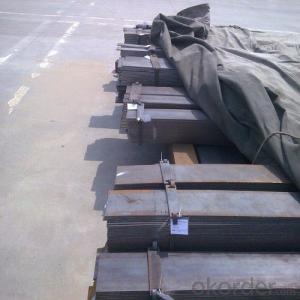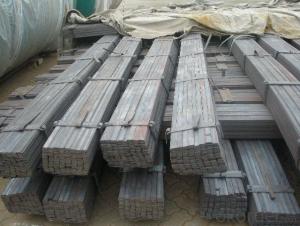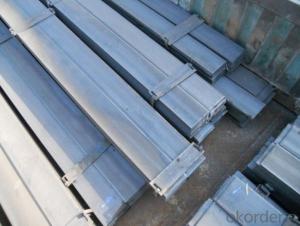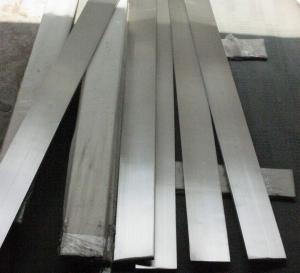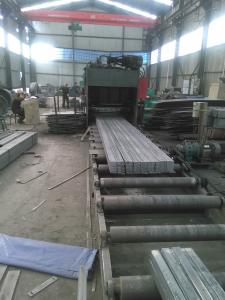Hot Rolled Flat Steel Bars with Material Grade Q235B
- Loading Port:
- Tianjin
- Payment Terms:
- TT OR LC
- Min Order Qty:
- 25 m.t.
- Supply Capability:
- 10000 m.t./month
OKorder Service Pledge
OKorder Financial Service
You Might Also Like
Product Description:
OKorder is offering high quality Hot Rolled Steel Flat bars at great prices with worldwide shipping. Our supplier is a world-class manufacturer of steel, with our products utilized the world over. OKorder annually supplies products to European, North American and Asian markets. We provide quotations within 24 hours of receiving an inquiry and guarantee competitive prices.
Product Applications:
Hot Rolled Steel Flat bars are ideal for structural applications and are widely used in the construction of buildings and bridges, and the manufacturing, petrochemical, and transportation industries.
Product Advantages:
OKorder's Steel Flat bars are durable, strong, and resist corrosion.
Main Product Features:
· Premium quality
· Prompt delivery & seaworthy packing (30 days after receiving deposit)
· Corrosion resistance
· Can be recycled and reused
· Mill test certification
· Professional Service
· Competitive pricing
Product Specifications:
Manufacture: Hot rolled
Grade: Q195 – 235
Certificates: ISO, SGS, BV, CIQ
Length: 6m – 12m, as per customer request
Packaging: Export packing, nude packing, bundled
Chemical composition of Q235
Alloy No | Grade | Element(%) | ||||
C | Mn | S | P | Si | ||
Q235 | B | 0.12—0.20 | 0.3—0.7 | ≤0.045 | ≤0.045 | ≤0.3 |
Physical properties of Q235
Alloy No | Grade | Yielding strength point(Mpa) | Tensile strength (Mpa) | Elongation after fracture(%) | ||||||
Thickness (mm) | Thickness (mm) | |||||||||
≤16 | >16--40 | >40--60 | >60--100 | ≤16 | >16--40 | >40--60 | >60--100 | |||
≥ | ≥ | |||||||||
Q235 | B | 235 | 225 | 215 | 205 | 375--500 | 26 | 25 | 24 | 23 |
FAQ:
Q1: Why buy Materials & Equipment from OKorder.com?
A1: All products offered by OKorder.com are carefully selected from China's most reliable manufacturing enterprises. Through its ISO certifications, OKorder.com adheres to the highest standards and a commitment to supply chain safety and customer satisfaction.
Q2: How do we guarantee the quality of our products?
A2: We have established an advanced quality management system which conducts strict quality tests at every step, from raw materials to the final product. At the same time, we provide extensive follow-up service assurances as required.
Q3: How soon can we receive the product after purchase?
A3: Within three days of placing an order, we will begin production. The specific shipping date is dependent upon international and government factors, but is typically 7 to 10 workdays.
Images:
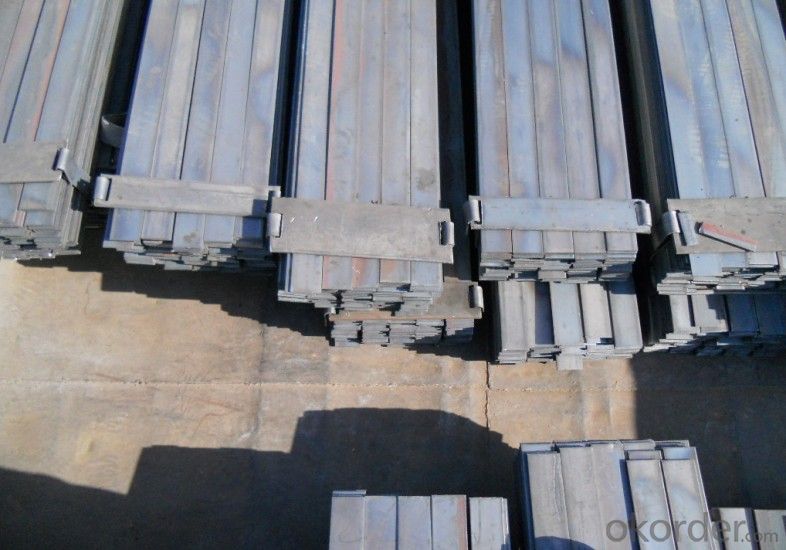
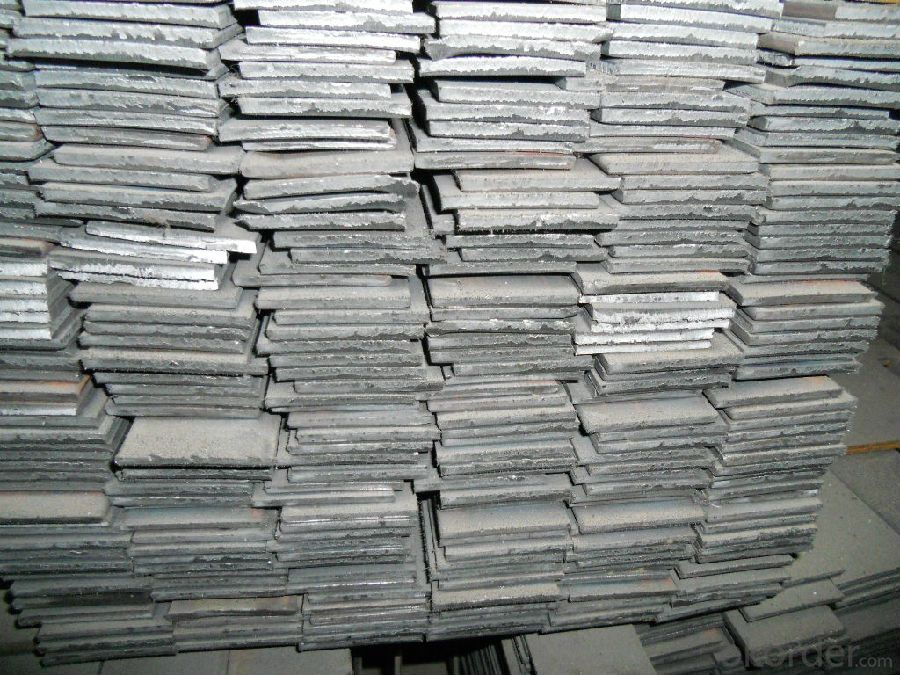
- Q:Can steel flat bars be used for making bicycle frames?
- Certainly! Bicycle frames can indeed be made using steel flat bars. Steel is a widely utilized material in the construction of bicycle frames owing to its robustness and long-lasting nature. The flat bars made of steel possess the essential stiffness and steadiness necessary for a bicycle frame. These bars can be molded and joined together via welding to create the diverse tubes and connections that constitute the frame. Moreover, steel is reasonably priced and easily accessible, thus making it a favored choice among both bicycle manufacturers and enthusiasts. However, it is crucial to acknowledge that the specific kind and caliber of steel employed can influence the performance and weight of the bicycle frame.
- Q:What are the different types of steel flat bars available in the market?
- There are several different types of steel flat bars available in the market, each with their own unique properties and applications. Here are some of the most common types: 1. Mild Steel Flat Bar: This is the most common type of steel flat bar and is widely used in various industries. It has a low carbon content, making it easy to work with and weld. Mild steel flat bars are used in construction, automotive, and general fabrication projects. 2. Stainless Steel Flat Bar: As the name suggests, stainless steel flat bars are made from stainless steel, which contains a minimum of 10.5% chromium. This type of steel is highly resistant to corrosion and staining, making it ideal for applications in marine environments, food processing, and chemical industries. 3. Alloy Steel Flat Bar: Alloy steel flat bars are made by adding elements such as manganese, nickel, chromium, or molybdenum to carbon steel. This enhances the strength, hardness, and durability of the steel. Alloy steel flat bars are commonly used in machinery, automotive, and tooling applications. 4. Tool Steel Flat Bar: Tool steel flat bars are specifically designed for making tools, dies, and molds. They are known for their high hardness, wear resistance, and toughness. Tool steel flat bars are available in various grades such as A2, D2, and O1, each with its own specific properties. 5. Galvanized Steel Flat Bar: Galvanized steel flat bars are coated with a layer of zinc to protect them from corrosion. This makes them suitable for outdoor applications, such as fencing, handrails, and grating. 6. Carbon Steel Flat Bar: Carbon steel flat bars contain higher levels of carbon compared to mild steel. They are known for their strength and hardness, making them suitable for structural and engineering applications. These are just a few examples of the different types of steel flat bars available in the market. The choice of the appropriate type depends on the specific requirements of the project, including strength, corrosion resistance, and desired application.
- Q:Do steel flat bars have a specific yield strength?
- Steel flat bars do indeed possess a specific yield strength, which refers to the amount of stress a material can endure before it undergoes permanent deformation. The determination of the yield strength of steel flat bars is reliant upon the grade or type of steel employed in their production. Varied grades of steel exhibit distinct yield strengths, typically measured in pounds per square inch (psi) or megapascals (MPa). For instance, ASTM A36, a frequently utilized grade for flat bars, boasts a yield strength of 36,000 psi or 250 MPa. In order to ensure the durability of steel flat bars in structural or load-bearing applications, it is crucial to take into account their specific yield strength, as it dictates their capacity to withstand forces without succumbing to permanent deformation.
- Q:What is the difference between hot-rolled and cast steel flat bars?
- The main difference between hot-rolled and cast steel flat bars lies in their manufacturing process. Hot-rolled steel flat bars are produced by heating a steel billet or ingot at a high temperature and then rolling it into the desired shape. This process results in a product with a relatively rough surface and slightly rounded edges. On the other hand, cast steel flat bars are made by melting steel and pouring it into molds to form the desired shape. This casting process results in a smoother surface and sharper edges. Overall, the choice between hot-rolled and cast steel flat bars depends on the specific application and aesthetic preferences.
- Q:How do you protect steel flat bars from chemical corrosion?
- There are several effective methods that can be utilized to safeguard steel flat bars from chemical corrosion. 1. Coating: To prevent chemical corrosion, it is common practice to apply a protective coating. There are numerous coating options available, including paint, epoxy, enamel, and polyurethane. These coatings act as a barrier between the steel surface and corrosive chemicals, thus reducing the risk of direct contact and subsequent corrosion. It is crucial to select a coating specifically designed for chemical resistance and ensure proper application for maximum effectiveness. 2. Galvanization: Another method to protect steel flat bars from chemical corrosion is through galvanization. This process involves applying a layer of zinc to the surface, creating a protective barrier against corrosive substances. Hot-dip galvanization is a widely used technique where the steel is immersed in molten zinc, resulting in a durable and thick coating. Galvanized steel flat bars exhibit high resistance to chemical corrosion and offer long-lasting protection. 3. Stainless steel: Incorporating stainless steel flat bars with a high chromium and nickel content can significantly enhance their resistance to chemical corrosion. The inclusion of these elements forms a passive layer on the surface, acting as a protective barrier against corrosive chemicals. Stainless steel is particularly suitable for applications where exposure to aggressive chemicals is anticipated. 4. Proper storage and handling: Proper storage and handling practices are crucial in safeguarding steel flat bars from chemical corrosion. Storing them in a dry and well-ventilated area, away from corrosive substances, can prevent direct exposure. Additionally, using protective covers or wrapping the bars in moisture-resistant materials can provide an additional layer of defense. Regular inspection and maintenance are also essential to promptly identify any signs of corrosion. If any damage or deterioration is detected, timely repairs or replacements should be carried out to maintain the integrity and longevity of the steel flat bars.
- Q:What are the different types of surface treatments for steel flat bars?
- There are several different types of surface treatments available for steel flat bars, each serving a specific purpose and providing unique benefits. Some of the common surface treatments for steel flat bars include: 1. Hot-dip galvanizing: This process involves immersing the steel flat bar in a bath of molten zinc, which forms a protective layer on the surface. Hot-dip galvanizing provides excellent corrosion resistance and durability, making it suitable for outdoor applications. 2. Powder coating: Powder coating involves applying a dry powder to the steel flat bar's surface and then curing it with heat. This process creates a tough and durable finish that is resistant to chipping, scratching, and fading. Powder coating is available in a wide range of colors and can enhance the aesthetic appeal of the steel flat bar. 3. Electroplating: Electroplating is a process where a thin layer of metal, such as chrome, nickel, or zinc, is deposited onto the steel flat bar's surface through an electrochemical reaction. This treatment improves corrosion resistance, enhances appearance, and can provide specific functional properties based on the chosen metal. 4. Paint coating: Applying a paint coating to the steel flat bar's surface provides both protection and aesthetics. Paint coatings can be customized to meet specific requirements and are available in various types such as epoxy, polyurethane, and acrylic. They offer good corrosion resistance and can be reapplied when necessary. 5. Anodizing: Anodizing is primarily used for aluminum, but it can also be applied to steel. The process involves creating an oxide layer on the surface of the steel flat bar through an electrolytic process. Anodizing enhances corrosion resistance and can be combined with coloring techniques to provide a decorative finish. 6. Phosphating: Phosphating is a chemical treatment that converts the steel flat bar's surface into a layer of phosphate crystals. This process improves corrosion resistance, provides an excellent base for subsequent coatings or paints, and enhances the adhesion of lubricants. 7. Shot blasting: Shot blasting is a mechanical surface treatment that involves propelling abrasive particles at high speeds onto the steel flat bar's surface. It removes impurities, rust, scale, and creates a textured finish, improving the adhesion of subsequent coatings. Each of these surface treatments offers distinct advantages and should be chosen based on the specific requirements of the steel flat bar's intended application, the desired appearance, and the level of corrosion resistance needed.
- Q:How do steel flat bars contribute to the overall safety of educational structures?
- The overall safety of educational structures is enhanced in multiple ways by the presence of steel flat bars. To begin with, steel flat bars are commonly employed in the construction of structural frames, supplying the necessary strength and stability to support the weight of the building. This guarantees that the educational structure remains structurally sound and able to withstand environmental forces like strong winds, earthquakes, and heavy snow loads. Moreover, steel flat bars are frequently used as reinforcement in concrete structures, such as beams and columns, increasing their load-bearing capacity and resistance to potential cracking or collapse. This reinforcement serves to prevent any structural failures that could jeopardize the safety of students, teachers, and other occupants. Additionally, steel flat bars possess a high degree of fire resistance, making them an excellent choice for educational structures. In the event of a fire, steel flat bars can endure high temperatures for an extended period, preserving the structural integrity of the building and allowing for safe evacuation. This fire resistance greatly reduces the risk of a catastrophic collapse and affords emergency responders valuable time to control the situation. Furthermore, steel flat bars are durable and long-lasting, minimizing the need for frequent maintenance or replacement. This ensures the ongoing safety of educational structures, as the structural components remain dependable and sturdy over time. In summary, steel flat bars are indispensable in promoting the overall safety of educational structures by providing strength, stability, fire resistance, and durability. Their use in construction contributes to the creation of secure and reliable buildings capable of withstanding various hazards, ultimately safeguarding the well-being of everyone within the educational environment.
- Q:Are steel flat bars available in different widths and thicknesses?
- Different widths and thicknesses are available for steel flat bars. They are widely used in construction and industrial settings due to their strong and durable support. These bars come in various widths and thicknesses to meet different project needs. The widths of steel flat bars typically range from 1/8 inch to 12 inches or more, while the thicknesses can vary from 3/16 inch to 2 inches or more. This broad range of sizes allows for versatility and customization in various construction and manufacturing projects. Additionally, steel flat bars can undergo further processing, such as cutting or bending, to meet specific dimensions or shapes required for a particular application.
- Q:Can steel flat bars be used in corrosive environments?
- No, steel flat bars are not recommended for use in corrosive environments as they are susceptible to rust and corrosion.
- Q:Are steel flat bars available in different surface finishes?
- Steel flat bars come in various surface finishes, providing different options for buyers. Some examples of common surface finishes for steel flat bars are mill finish, hot rolled, cold rolled, brushed, polished, and galvanized. Each surface finish possesses its own distinct characteristics and is suitable for different purposes. Mill finish is the initial surface finish achieved after manufacturing steel, while hot rolled steel flat bars have a rougher texture and are commonly used for structural applications. On the other hand, cold rolled steel flat bars have a smoother surface finish and are often utilized in decorative applications. Brushed and polished finishes offer a more refined and aesthetically pleasing appearance. Meanwhile, galvanized steel flat bars are coated with zinc to provide protection against corrosion. In summary, the availability of various surface finishes allows steel flat bars to be utilized in a wide range of applications, while also meeting specific requirements for appearance and functionality.
1. Manufacturer Overview |
|
|---|---|
| Location | |
| Year Established | |
| Annual Output Value | |
| Main Markets | |
| Company Certifications | |
2. Manufacturer Certificates |
|
|---|---|
| a) Certification Name | |
| Range | |
| Reference | |
| Validity Period | |
3. Manufacturer Capability |
|
|---|---|
| a)Trade Capacity | |
| Nearest Port | |
| Export Percentage | |
| No.of Employees in Trade Department | |
| Language Spoken: | |
| b)Factory Information | |
| Factory Size: | |
| No. of Production Lines | |
| Contract Manufacturing | |
| Product Price Range | |
Send your message to us
Hot Rolled Flat Steel Bars with Material Grade Q235B
- Loading Port:
- Tianjin
- Payment Terms:
- TT OR LC
- Min Order Qty:
- 25 m.t.
- Supply Capability:
- 10000 m.t./month
OKorder Service Pledge
OKorder Financial Service
Similar products
New products
Hot products
Related keywords
